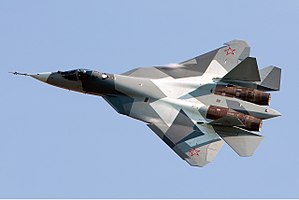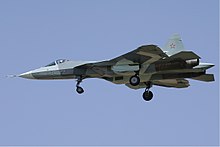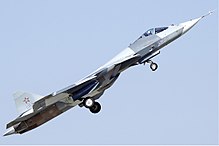From Wikipedia, the free encyclopedia
| PAK FA | |
|---|---|
| PAK FA T-50 | |
| Role | Stealth multirole fighter |
| National origin | Russia |
| Manufacturer | Sukhoi |
| First flight | 29 January 2010[1] |
| Introduction | 2016[2] |
| Status | Test flight/pre-production |
| Primary users | Russian Air Force Russian Navy[3] |
| Number built | 5 prototypes[4] |
| Program cost | US$8–10 billion (est.)[5][6][7] |
| Unit cost | T-50: US$50+ million[8]< FGFA: US$100 million[9] |
| Variants | Sukhoi/HAL FGFA |
The PAK FA, a fifth generation jet fighter, is intended to be the successor to the MiG-29 and Su-27 in the Russian inventory and serve as the basis of the Sukhoi/HAL FGFA being developed with India.[12][13] The T-50 prototype performed its first flight 29 January 2010.
The Russian Defence Ministry will purchase the first 10 evaluation example aircraft after 2012 and then 60 production standard aircraft after 2016.[14][15][16] The first batch of fighters will be delivered with current technology engines. The PAK-FA is expected to have a service life of about 30–35 years.[17]
Development
Origins
In the late 1980s, the Soviet Union outlined a need for a next-generation aircraft to replace its MiG-29s and Su-27s in front line service. Two projects were proposed to meet this need – the Sukhoi Su-47 and the Mikoyan Project 1.44. In 2002, Sukhoi was chosen to lead the design for the new combat aircraft.[18] The Novosibirsk Aircraft Production Association is manufacturing the new multirole fighter at Komsomol'sk-on-Amur along with Komsomolsk-on-Amur Aircraft Production Association. Final assembly is to take place at Komsomol'sk-on-Amur.[citation needed]The Tekhnokompleks Scientific and Production Center, Ramenskoye Instrument Building Design Bureau, the Tikhomirov Scientific Research Institute of Instrument Design, the Ural Optical and Mechanical Plant (Yekaterinburg), the Polet firm (Nizhny Novgorod) and the Central Scientific Research Radio Engineering Institute (Moscow) were pronounced winners in the competition held in early 2003 for the development of the avionics suite. NPO Saturn is the lead contractor for the engines.[citation needed]
In 2007, Russia and India agreed to jointly develop the Fifth Generation Fighter Aircraft Programme (FGFA) for India.[19][20][21] In September 2010, it was reported that India and Russia had agreed on a preliminary design contract where each country invests $6 billion; development of the FGFA fighter was expected to take 8–10 years.[22] The agreement on the preliminary design was to be signed in December 2010.[23]
On 8 August 2007, Russian Air Force Commander-in-Chief (CinC) Alexander Zelin was quoted by Russian news agencies that the development stage of the PAK FA program was complete and construction of the first aircraft for flight testing would begin.[24] Zelin also said that by 2009 there would be three fifth-generation aircraft ready. "All of them are currently undergoing tests and are more or less ready," he said.[25] In mid-2009 the design was approved.[18]
Flight testing
The T-50's maiden flight had been repeatedly postponed since early 2007 as the aircraft encountered unspecified technical problems. Alexander Zelin admitted as recently as August 2009 that problems with the engine and in technical research remained unsolved.[26] On 28 February 2009, Mikhail Pogosyan announced that the airframe for the aircraft was almost finished and that the first prototype should be ready by August 2009.[27] On 20 August 2009, Pogosyan said that the first flight would be by year's end. Konstantin Makiyenko, deputy head of the Moscow-based Centre for Analysis of Strategies and Technologies said that "even with delays", the aircraft would likely make its first flight by January or February, adding that it would take five to ten years for commercial production.[28]On 8 December 2009, Deputy Prime Minister Sergei Ivanov announced that the first trials with the fifth-generation aircraft would begin in 2010.[29] The first taxi test was successfully completed on 24 December 2009.[30][31][32] Piloted by Hero of the Russian Federation Sergey Bogdan, the aircraft's 47-minute maiden flight took place on 29 January 2010 at KnAAPO's Dzemgi Airport in the Russian Far East.[33][34][35][36]
By 31 August 2010, it had made 17 flights and by mid-November, 40 in total. The second T-50 was to start its flight test by the end of 2010, but this was delayed until March 2011.[37][38][39][40][41]
A second prototype was first planned to join the flight testing in the fourth quarter of 2010 but was postponed. On 3 March 2011, it was reported that the second aircraft had made a successful 44-minute test flight.[37] These first two aircraft will lack radar and weapon control systems. The third and fourth aircraft, to be added in 2011, will be fully functional test aircraft.[42] On 14 March 2011, the aircraft achieved supersonic flight at a test range near Komsomolsk-on-Amur in Siberia.[43]
The T-50 was displayed publicly for the first time at the 2011 MAKS Airshow. Russian Prime Minister Vladimir Putin was in attendance.[44][45] In June 2011, an unauthorized video was made of the Sukhoi PAK FA in flight displaying a variety of aerobatic moves.[46] On 3 November 2011, the PAK FA program achieved its 100th flight.[47] More than 20 test flights were made in the next nine months.[48]
The third prototype, T-50-3, was the first prototype to fly with an AESA radar. Originally scheduled for the end of 2011, these flights occurred in August 2012, and showed performance comparable to existing radars.[49][50] On 22 November 2011, T-50-3 took its first flight from KnAAPO's airfield in Komsomolsk-on-Amur, piloted by Sergey Bogdan. The aircraft spent over an hour in the air, and was subjected to basic stability and powerplant checks.[51] It differs from the other prototypes in the way it lacks a pitot tube. All 14 test aircraft are scheduled to fly by 2015.[52]
The fourth prototype had its first flight on 12 December 2012[53] and joined the other three aircraft in testing near Moscow a month later.[54][55]
Design
Overview
Although most information about the PAK FA is classified, sources within in the Russian Air Force and Defense Ministry have openly stated that it features stealth technology and has the capability to supercruise,[6] and incorporate advanced avionics such as an Active Electronically Scanned Array (AESA) radar and an artificial intelligence system.[56] It is to be outfitted with the next generation of air-to-air, air-to-surface, and air-to-ship missiles.[57]Video from the PAK FA's first flight shows that it has no conventional rudders; its vertical tails are fully movable.[58] This special tail fin design is mechanically similar to V-tails used by the Northrop YF-23 in 1990s,[59] but is supplemented by dedicated horizontal stabilators (as on the F-22). The T-50 has wing leading-edge devices above the jet engine intakes that may pose a challenge for signature control.[60]
Composites are used extensively on the T-50 and comprise 25% of its weight and almost 70% of the outer surface.[42] It is estimated that titanium alloy content of the fuselage is 75%. Sukhoi's concern for minimizing radar cross-section (RCS) and drag is also shown by the provision of two tandem main weapons bays in the centre fuselage, between the engine nacelles. Each is estimated to be between 4.9-5.1 m long. The main bays are augmented by bulged, triangular-section bays at the wing root.[61]
The Moskovsky Komsomolets reported that the T-50 has been designed to be more maneuverable than the F-22 Raptor, at the cost of making it less stealthy than the F-22.[62] One of the design elements that have such an effect is the Leading Edge Vortex Controller (LEVCON).
Cockpit
Life support systems will enable pilots to sustain 9 g in maneuvers. New pressure suits will allow safe ejection at altitudes of up to 23 km.[63]Stealth
Russian sources indicate the PAK FA lacks the very-low-observable (VLO) stealth of the F-22. Instead, reducing observability with composite materials, aerodynamic configuration, and engine signature reduction measures to achieve low (but not very-low) levels of radar, optic and infrared signatures.[64] Carlo Kopp has said that once the PAK FA is fully developed into a stealthy design, it should be a rough match for the F-35 in low observability, but aerodynamically superior.[65] Sources claim that the PAK FA may incorporate "Plasma stealth" although no solid evidence of this has been shown.[citation needed]Armament
The PAK FA has a reported maximum weapons load of 7,500 kg.[66] It has an apparent provision for a cannon (most likely GSh-301), and could possibly carry two 30 mm cannons.[17] The PAK FA has two internal bays estimated at 4.6-4.7 metres by 1-1.1 metres.[67] The expected initial armaments include Kh-35UE (AS-20 "Kayak"), Kh-38ME, Kh-58UShKE (AS-11 "Kilter"), and RVV-MD (AA-11 "Archer") missiles.[68]Two Izdeliye 810 Extended beyond visual range missiles per weapons bay. Multiple Izdeliye 180 / K77M beyond visual range missiles. K74 and K30 within visual range missiles can also be carried.[67] Two KH38M or KH58 USHK air-to-ground missiles per weapons bay. Multiple 250–500 kg precision guided bombs per weapons bay,[67] with a maximum of 10 bombs in internal bays.[66] Other possible loads include one 1,500 kg bomb per weapons bay or two 400 km+ range anti-AWACS weapons (such as the RVV-BD) on external hardpoints.[69][70]
PAK FA chief designer Alexander Davydenko has said that there is a possibility of the installation of BrahMos supersonic missile on the PAK FA and its FGFA derivative. However, it is unclear how these missiles will be installed, though it can be one or two missiles only due to heavy weight of the BrahMos.[71]
Avionics
The PAK FA will feature an OLS-50M infra-red search and track optical/IR search and tracking system. The OLS-50M is an upgrade to the previous OLS-35 infra-red search and track system due to advanced QWIP technology now being available. The OLS-50M will most likely have upgraded efficiency in identifying VLO (very low observability) aircraft at greater ranges.[citation needed]
Engines
On its first flights, the PAK FA was expected to use a pair of conventional Saturn 117S engines, but a new engine 117 (AL-41F1) powered its first flight.[77] The new engine features a digital control system (FADEC), and is reportedly capable of producing 33,000 lbs (147 kN) of thrust in afterburner, has a dry weight of 1420 kilogram and a thrust to weight ratio of 10.5:1.[78]According to Sukhoi director Mikhail Pogosyan, the 117 (AL-41F1) is a new fifth generation engine built specifically for the PAK-FA. Pogosyan has clarified that claims of the use of an older engine are incorrect. Though the specifics of the new engine remain classified, information provided has included: increased engine thrust by 2.5 tonnes over the AL-31 engine, a reduction in engine weight by 150 kilograms (330 lb). These changes allow the aircraft to supercruise, sustaining supersonic flight speeds without using afterburners.[78] Mikhail Pogosyan further mentioned that this engine (117) meets the Russian Air Force's requirements and will be installed in production PAK-FA aircraft.[78]
The engine generates a larger thrust and has a complex automation system, to facilitate flight modes such as maneuverability. It is expected that each engine will be able to independently vector its thrust upwards, downward or side to side. Vectoring one engine up with the other one down can produce a twisting force, which would enable the PAK FA to be the first fifth generation fighter with full 3-D thrust vectoring along all three aircraft axes: pitch, yaw and roll. These engines will incorporate infrared and RCS reduction measures.[79][80]
There is little information about the new engine of T-50. According to preliminary facts, the engine will have increased thrust and fuel efficiency as compared to AL-41F1. Allegedly, the powerplant will have a thrust of about 107 kN in cruise mode and 176 kN in full afterburner mode.[81]
Operational history
In March 2013, the first aircraft is to be delivered for two years of state trials.[84][85] As of June 2012, construction of modernized testing facilities and a new runway to accommodate the next phase of the PAK FA program is underway at the 929th State Flight Test Center in Akhtubinsk.[86][87]
On 6 August 2013, the Russian Air Force announced they will take delivery of their first T-50 "in the third quarter of this year," with final state test flights starting in the fourth quarter. The aircraft will enter service in 2016.[88]
Exports
Sukhoi claims that the main export advantage of the PAK FA consists in it being cheaper than current US fifth generation jet fighters, though it will be considerably more expensive than previous Russian fourth generation jet fighters.[89]Russia was said to be interested in offering the PAK FA for South Korea's next generation jet fighter.[90] South Korea's defence procurement agency confirmed that the Sukhoi PAK FA was a candidate for the Republic of Korea Air Force's next-generation fighter (F-X Phase 3) aircraft;[91] however, Sukhoi failed to enter the bidding competition by the January 2012 deadline.[92]
Russia's Centre for Analysis of World Arms Trade predicts that the PAK FA will be available for export in 2025;[93] though this may include the Sukhoi/HAL FGFA,[94] the primary export version of the base T-50 platform.[95]
Ruslan Pukhov, director of the Centre for Analysis of Strategies and Technologies, has projected that Vietnam will be the second export customer for the fighter.[96]
In 2012, Russian Defense Minister Anatoly Serdyukov said that Russia and India would jointly build the export version of the T-50 starting in 2020.[97]
In 2013 United Aircraft Corporation president Mikhail Pogosyan said that the Russian PAK FA would use the "identical onboard systems and avionics" of the Sukhoi/HAL FGFA.[98]
Variants
FGFA
Main article: Sukhoi/HAL FGFA
The completed joint Indian/Russian versions of the single-seat or
two-seat FGFA will differ from the current T-50 flying prototypes in 43
ways with improvements to stealth, supercruise, sensors, networking, and
combat avionics.[99]Sukhoi director Mikhail Pogosyan has projected a market for 1,000 fighter aircraft over the next four decades, which will be produced in a joint venture with India, 200 each for Russia and India and 600 for other countries.[100] He has also said that the Indian contribution would be in the form of joint work under the current agreement rather than as a joint venture.[101] The Indian Air Force is to receive 50 of the single-seat "Russian version" before receiving the two-seat FGFA.[102]
Navalized Sukhoi T-50 PAK FAs will be deployed on the Russian aircraft carrier Admiral Kuznetsov and future Russian aircraft carriers.[103] There will be a competition between the Sukhoi, Mikoyan and Yakovlev design bureaus to choose the new naval aircraft.[3]
Alexei Fedorov has said that any decision on applying fifth-generation technologies to produce a smaller fighter (comparative to the F-35) must wait until after the heavy fighter, based on the T-50, is completed.[104]
Specifications
Because the aircraft is in development, these specifications are preliminary and are taken as estimates from the available images.General characteristics
- Crew: 1
- Length: 19.8 m (65.9 ft)
- Wingspan: 14 m (46.6 ft)
- Height: 6.05 m (19.8 ft)
- Wing area: 78.8 m2 (848.1 ft2)
- Empty weight: 18,500 kg (40,785 lb)
- Loaded weight: 29,772 kg[N 1] (65,636 lb)
- Useful load: 7,500 kg (combat load) (16,534 lb)
- Max. takeoff weight: 37,000 kg (81,570 lb)
- Powerplant: 2 × AL-41F1 for prototypes[N 2][107] turbofan, 147 kN (33,047 lb) for prototypes;[108] over 175 kN (39,340 lbf) for definitive engine version[108][109] each
- Fuel capability: 10,300 kg (22,711 lb)[105]
- Maximum speed: Mach 2+, 2,135 km/h [110] (1,327 mph)
- Cruise speed: 1,300-1,800 km/h[107] (808-1,118 mph)
- Ferry range: 5,500 km[111] (3,417 mi)
- Service ceiling: 20,000 m (65,000 ft)
- Rate of climb: 350 m/s (68,900 ft/min)
- Wing loading: 330-470 kg/m2 (67-96 lb/ft2)
- Thrust/weight: 1.01 (1.20 for new engines)
- Maximum g-load: 9 g[63]
- Guns: None on prototype. Apparent provision for a cannon (most likely GSh-301). Possible two 30 mm cannon.[17]
- Hardpoints: Currently 6 internal hardpoints and up to 6 external hardpoints: two internal bays running longitudinally on the fuselage supporting 4 R-77-derived AAMs (2 each) or 4 R-33/R-37 AAMs (2 each), plus 2 small internal wing bays for 2 R-73-derived AAMs and up to six external hardpoints.[112] Including the advanced X-38 air to surface missile.[113]
[114]
- AESA N050 built by Tikhomirov NIIP. Presumably T-50 radar is a development of Irbis-E designed for Su-35BM[115][116]
- Speculated specifications: Radar complex Sh-121 comprising five elements, namely
- Main X-band AESA radar, size of 900 by 700 mm and with 1522 T/R modules
- 2 Side facing smaller X-band AESA radars, to increase angular coverage
- 2 L-band AESA on the Leading-edge extension for good vlo detection
- Possible rear facing X-band AESA for the Indian Sukhoi/HAL FGFA
- Speculated specifications: Radar complex Sh-121 comprising five elements, namely
- OEIS (opto-electronic integrated system) 101KS: Consists of 4 parts[109][117]
- 101KC-D: Anti-IR seeker
- 101KC-B: Quantam optical radar system
- 101KC-Y: Optical system for issuing HQ to COP-O
- 101KC-H: Air to ground mode
See also
- Related development
- Aircraft of comparable role, configuration and era
- Related lists







No comments:
Post a Comment